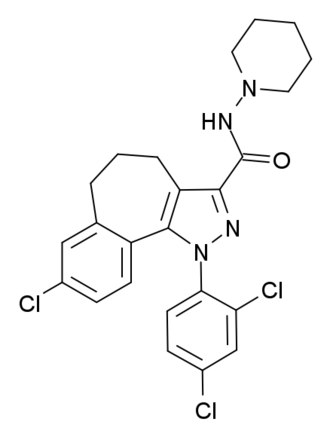Summary
NESS-0327 is a pharmaceutical substance utilized in scientific investigations, recognized for its remarkable role as a highly potent and exceedingly selective antagonist of the cannabinoid receptor CB1. Its antagonistic potency greatly surpasses the more commonly employed ligand, rimonabant. With an astounding Ki at CB1 measuring a mere 350 femtomolar (0.00035 nanomolar), NESS-0327 exhibits an extraordinary preference for CB1 over CB2, showcasing a selectivity that exceeds 60,000-fold.
It’s worth noting that, independently, two other research groups have reported more modest nanomolar affinities for CB1 concerning this compound, with values of 125 and 18.4 nanomolar. Unlike rimonabant, NESS-0327 doesn’t function as an inverse agonist at higher concentrations. Instead, it is a strictly neutral antagonist, effectively obstructing the CB1 receptor without eliciting any intrinsic physiological responses.
| Identifiers | |
|---|---|
| CAS Number | 494844-07-4 |
| PubChem CID | 10435654 |
| ChemSpider | 8611079 |
| UNII | X1BQI2J97I |
| CompTox Dashboard (EPA) | DTXSID00439851 |
| Chemical and physical data | |
| Formula | C24H23Cl3N4O |
| Molar mass | 489.83 g·mol−1 |

FAQ
1. What is NESS-0327?
NESS-0327 is a pharmaceutical compound used in scientific research. It’s renowned for its role as a potent and highly selective antagonist of the cannabinoid receptor CB1.
2. How does NESS-0327 differ from rimonabant?
NESS-0327 surpasses rimonabant in terms of its antagonistic potency at CB1. It also exhibits a remarkable selectivity for CB1 over CB2, making it a unique research tool.
3. What is the Ki value for NESS-0327 at CB1?
NESS-0327 boasts an impressively low Ki value at CB1, measuring 350 femtomolar (0.00035 nanomolar), highlighting its exceptional binding affinity.
4. Is NESS-0327 only selective for CB1?
While it primarily targets CB1, it’s essential to note that different studies have reported varying affinities for this compound, with modest nanomolar values for CB1. However, its selectivity remains substantial.
5. Does NESS-0327 act as an inverse agonist?
Unlike other compounds, NESS-0327 does not appear to act as an inverse agonist at higher concentrations. It functions as a neutral antagonist, blocking CB1 without inducing physiological effects of its own.
6. How is NESS-0327 used in scientific research?
Researchers use NESS-0327 to explore the functions and mechanisms of the cannabinoid receptor CB1. It is a valuable tool for investigating the endocannabinoid system and related physiological processes.
7. Are there any potential applications of NESS-0327 beyond research?
NESS-0327 is primarily a research tool and hasn’t been approved for clinical use. Its significance lies in its contributions to scientific understanding.
8. Where can I obtain NESS-0327 for research purposes?
NESS-0327 is typically available through specialized chemical suppliers and research institutions focusing on cannabinoid receptor-related research. It is essential to ensure that you comply with all legal and ethical regulations when obtaining and using this compound.
9. Are there any safety considerations when working with NESS-0327?
As with any potent compound, it’s crucial to follow strict safety protocols when handling NESS-0327 in a laboratory setting. Researchers should adhere to established safety guidelines and regulations.
10. Where can I find more information about NESS-0327 and its research applications?
You can refer to scientific journals, research articles, and academic resources in cannabinoid receptor research for in-depth information about NESS-0327 and its applications. Additionally, consult with experts and institutions specializing in this area for further guidance.
References
- In July 2003, Ruiu S, Pinna GA, Marchese G, Mussinu JM, Saba P, Tambaro S, and their team unveiled NESS 0327, a groundbreaking putative antagonist of the CB1 cannabinoid receptor. Their research, featured in The Journal of Pharmacology and Experimental Therapeutics (Volume 306, Issue 1, pages 363–70), offered insights into the synthesis and characterization of this innovative compound. The study is accessible through doi:10.1124/jpet.103.049924, and its PMID is 12663689. Additionally, S2CID 32018707 is associated with this work.
- In August 2002, Stoit AR, Lange JH, Hartog AP, Ronken E, Tipker K, Stuivenberg HH, and their colleagues embarked on the design, synthesis, and exploration of the biological activity of rigid cannabinoid CB1 receptor antagonists. Their findings were published in the Chemical & Pharmaceutical Bulletin (Volume 50, Issue 8, pages 1109–13). For further details, the study can be accessed through doi:10.1248/cpb.50.1109, and its PMID is 12192147.
- In June 2008, Zhang Y, Burgess JP, Brackeen M, Gilliam A, Mascarella SW, Page K, and others ventured into the realm of conformationally constrained analogues of N-(piperidinyl)-5-(4-chlorophenyl)-1-(2,4- dichlorophenyl)-4-methyl-1H-pyrazole-3-carboxamide (SR141716). Their work encompassed design, synthesis, computational analysis, and biological evaluations. This research was published in the Journal of Medicinal Chemistry (Volume 51, Issue 12, pages 3526–39) and can be explored in-depth through doi:10.1021/jm8000778. The PMID is 18512901.
- Moving forward to November 2005, Tambaro S, Mongeau R, Dessi C, Pani L, and Ruiu S conducted research focused on the modulation of ATP-mediated contractions of the rat vas deferens through presynaptic cannabinoid receptors. Their study, featured in the European Journal of Pharmacology (Volume 525, Issues 1–3, pages 150–3), delved into this intriguing aspect of cannabinoid receptor function. The research is accessible through doi:10.1016/j.ejphar.2005.09.058, and its PMID is 16271359.